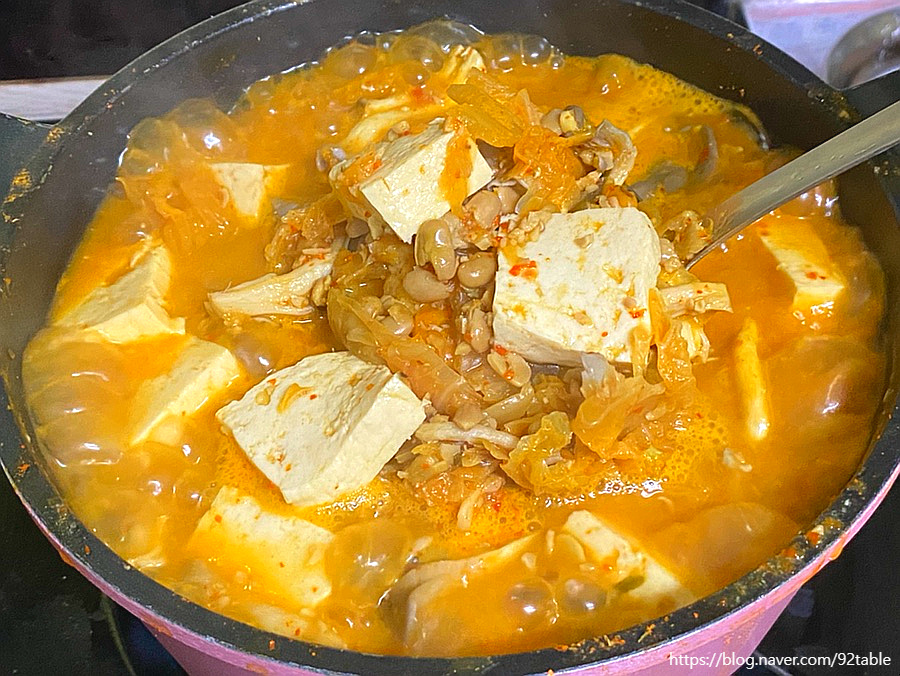Delicious Cheonggukjang Jjigae (Fermented Soybean Paste Stew) – The Golden Recipe
Rice Thief! Cheonggukjang Jjigae with Deep and Rich Flavor – Unveiling the Secret to Easy Success

Today, I’ll share a secret recipe for Cheonggukjang Jjigae, a stew with a deep, savory flavor that’s incredibly delicious using simple ingredients from your fridge. Get ready for a bowl of rice to disappear in an instant with this magical Cheonggukjang Jjigae. Let’s get started!
Main Ingredients- Well-fermented Kimchi 1 cup ~ 1.5 cups
- Mushroom 1 (Shiitake, King Oyster, etc., optional)
- Korean Zucchini (Hobak) 1/3 (optional)
- Potato 1 (optional)
- Tofu 1 block
Seasoning & Broth- Perilla Oil (Deulgireum) 2 Tbsp
- Anchovy-Kelp Broth 1.2 Liters (1.2L water + a handful of dried anchovies)
- Minced Garlic 1 Tbsp
- Gochugaru (Korean Red Pepper Flakes) 1 Tbsp (adjust to taste)
- Cheonggukjang (Fermented Soybean Paste) 180g ~ 200g
- Fish Sauce (Anchovy) 2 Tbsp (can substitute with soy sauce or salted shrimp)
- Perilla Oil (Deulgireum) 2 Tbsp
- Anchovy-Kelp Broth 1.2 Liters (1.2L water + a handful of dried anchovies)
- Minced Garlic 1 Tbsp
- Gochugaru (Korean Red Pepper Flakes) 1 Tbsp (adjust to taste)
- Cheonggukjang (Fermented Soybean Paste) 180g ~ 200g
- Fish Sauce (Anchovy) 2 Tbsp (can substitute with soy sauce or salted shrimp)
Cooking Instructions
Step 1
In a deep pot, heat 2 tablespoons of perilla oil. Add 1 to 1.5 cups of prepared kimchi and spread it out to prevent sticking to the bottom of the pot.

Step 2
Cook the kimchi over medium-low heat for about 5 minutes, until it becomes sweet and tender. Stir-frying the kimchi this way removes any raw taste and enhances its savory flavor.

Step 3
While the kimchi is stir-frying, prepare the anchovy-kelp broth in another pot or kettle. Bring 1.2 liters of water to a boil with a handful of dried anchovies. (You can also use store-bought broth.)

Step 4
Pour all the prepared anchovy-kelp broth into the pot with the stir-fried kimchi. The anchovy broth will deepen the flavors of the ingredients.

Step 5
Feel free to use up any leftover vegetables or mushrooms you have in your fridge. Adding vegetables like Korean zucchini or potatoes, cut into bite-sized pieces, will make the stew even richer. (I used a frozen vegetable mix!)

Step 6
Once the broth starts to boil, add 1 tablespoon of minced garlic and 1 tablespoon of gochugaru for a spicy kick. Gochugaru plays an important role in the stew’s color and level of spiciness.

Step 7
Now it’s time to add the flavor of cheonggukjang. Add 180g to 200g of cheonggukjang and use a ladle or spoon to break it up and dissolve it well into the broth without lumps. Be careful not to overcook the cheonggukjang, as it can diminish its savory aroma.

Step 8
Bring the stew to a boil uncovered over high heat. Once it’s bubbling vigorously, reduce the heat to medium and add 2 tablespoons of anchovy fish sauce to season. Fish sauce adds umami and helps balance any bitterness from the cheonggukjang. (You can substitute with soy sauce or salted shrimp; adjust seasoning to your preference.)

Step 9
When the savory flavor of the cheonggukjang has well infused into the broth, gently add 1 block of tofu, cut into bite-sized pieces. Be careful not to break the tofu as you add it.

Step 10
Simmer for a little longer after adding the tofu, and your Cheonggukjang Jjigae is complete! The tofu will absorb the warm broth, making it soft and delicious. Enjoy it hot with a bowl of rice!




